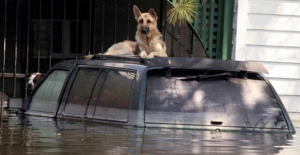Good morning! Ready to think like a dog for today’s quick write?
 Our guest author is Dayna Lorentz, the author of the Dogs of the Drowned City series (Scholastic) and the No Safety in Numbers trilogy (Dial/Kathy Dawson Books). She holds an MFA in Creative Writing and Literature from Bennington College. A former attorney, Dayna is now a full-time writer and lives with her husband, two kids, and dogs in Vermont. If you ask nicely, she will show you the proper way to eat a cupcake. Visit her at www.daynalorentz.com. Check out the thrilling book trailer for No Safety at NoSafetyinNumbersBooks.com.
Our guest author is Dayna Lorentz, the author of the Dogs of the Drowned City series (Scholastic) and the No Safety in Numbers trilogy (Dial/Kathy Dawson Books). She holds an MFA in Creative Writing and Literature from Bennington College. A former attorney, Dayna is now a full-time writer and lives with her husband, two kids, and dogs in Vermont. If you ask nicely, she will show you the proper way to eat a cupcake. Visit her at www.daynalorentz.com. Check out the thrilling book trailer for No Safety at NoSafetyinNumbersBooks.com.
Writing from a Dog’s-Eye-View of the World
My first series, Dogs of the Drowned City (Scholastic 2012), is an animal fantasy adventure series for middle grade readers, and is told from the point of view of Shep, a German shepherd dog. The biggest challenge I faced in writing this series was trying to capture how Shep—as opposed to a human (a/k/a me)—perceives the world. I wanted to create for readers the world of the story as Shep and my other dog characters experienced it. To do this, I focused on three things.
First, I tried to describe everything using a dog’s primary senses: smell and sound, then sight. This is really hard for a sight-dependent human like me! It means talking about what the grass smells like and how it whispers as it moves in the wind before talking about the fact that it’s green.
Second, I had to think about the human world from a dog’s point of view. This meant figuring out what would most interest a dog in the human world. I guessed smelly things like socks and leftovers. I also had to think about how a dog might describe human things that are totally alien to them, like vacuum cleaners. (During school visits, I ask kids to come up with their own descriptions for a vacuum cleaner. Shep calls them “floor suckers.”)
Finally, I changed the language I used in the book to reflect how I thought a dog would talk. I made up dog idioms and sayings, and tried to put a doggy spin on my descriptions, such as describing daybreak as “the tails of dawn wagging in the sky.”
These steps forced me to get out of my own, limited point of view and put myself into the limited point of view of another person/dog, an exercise that can be helpful even if you’re not writing from the viewpoint of a different species. I found that I had to do similar, though perhaps not as extreme, exercises when writing my YA trilogy, No Safety in Numbers (Dial 2012): How would this particular character describe the smell of the food court at the mall? What things would she notice that maybe I wouldn’t?
So, getting to the writing prompt: I’m going to give you two! If you’d like to take a break from your work-in-progress and think like a dog for a little while, try this out:
The first Dogs of the Drowned City book, The Storm, is about a pack of pets trying to survive a super storm that wipes out Miami. A lot of my research, therefore, focused on Hurricane Katrina and the thousands of pets left stranded in the city when people were evacuated and told they could not bring their furry family members with them. This picture is one of the many I found of those Katrina Dogs.
Write a scene from the point of view of one of the dogs pictured above. Focus on making the scene as doggy as possible. Try employing these tricks:
- Describe things smell first, then sight
- Though a dog’s eyesight is far better than a human’s, a dog sees in a limited palate of colors, mostly yellow or blue, so these dogs would not, for example, talk about the bright red sedan submerged across the street from them.
- As a dog, you have four paws — use them!
- Dogs can communicate in many different ways. They bark and growl, but also use their ears, tails, and stance to signal how they’re feeling.
If you’re deeply submerged in your work-in-progress and don’t want to surface, try taking a scene, maybe the scene you’re working on, and list all the ways in which you would describe and talk about your surroundings. Then make a separate list for how your character would describe and talk about those same things. How are they the same? Should they be the same, or have you missed an opportunity to move the story further from yourself and into the space of your character? Think about the metaphors you’re using—are they yours or the character’s? One of my characters in No Safety is VERY different from me. With him, I wrote his chapters, then went back and edited all the sentences to make them less complex, and took out all the metaphorical language because that just wasn’t him—it was me talking about him and his situation, but not really being him in that situation.
Happy writing! As always, feel free to share a few lines of today’s writing in the comments if you’d like!






Interesting quick write to shake me out of my comfort zone. Thanks, Dayna.
Heard the boat before I saw it. Puttered around the corner, carrying two people. Most people used to smell like coconut or apples around here, but now it’s just sweat, though it’s harder to detect over the bad-egg stink from so much water. The person in back steers, and he’s bringing the boat closer. The person in the front has something in her hands, raised to her face. I start to hear clicking.
My paws feel wet, and I realize that the nearing boat has pushed water over the hood of the car where I stand. I flatten my ears, roll a growl around my throat – usually just enough to freeze whoever is near. But the boat keeps coming, and the woman keeps clicking the thing she’s holding. I see a twinkle of light between her hands. Whatever she’s got there is shiny, and it’s pointed just above me, to my left. I turn to look.
I forgot about the German shepherd on the roof of the car. Looks like he’s showing off: sitting alertly, pointy ears perked. Except I’m the only one near enough to hear his low whimper.
My cold, soaked paws remind me I wish I was up there, but that’s not to be. Instead, I wish the boat would go away, so I can have my low-lying island back from the rising water. Either that or food, my stomach grumbles. People used to bring me things to eat, and maybe the ones in the boat are no different. I quiet down and lick my chops.
Hi Brian! This is great! I love the “roll a growl around my throat,” very evocative! I heard that dog, I knew what he was trying to say. It’s great how you brought a lot of “dogginess” to the narration–wet paws, smells and sounds dominating description. You also created a scene in a very few deft strokes–the narrator goes from wary and instinctive, a part of the wild, wrecked world, back to the world before, where he knew kindness from people. I also love how you established a relationship between the dogs indirectly. I’d love to see a scene between them–it sounds like your narrator (the white dog, barely visible) is the dominant one, so why did he (he sounds like a he:) cede the top part of the car? Is this some sort of ploy the two cooked up–put the cute German shepherd out front to bring in food? Is the shepherd bait? Intriguing dynamic! Great work!
Hi Dayna,
I took a break from my WIP and took a stab at this writing prompt. It is always interesting to me when I try to put myself in other people’s shoes and view the world, but to put myself in paws…well. Anyway, here goes…
I picked up my head and flopped my ears to shake the sleep away. Something smells weird. I flap my nostrils, searching the air, here and there, and there it is. What is that smell? Lake washed fur, I think. Wait… I don’t remember going to sleep at our camp by the lake? My nose pulls me up. Is it another dog? I push up just a bit, haunched on this flat, surface that burns my eyes. I squint and flap my nostrils taking in more air. It is another dog. He’s up there. I push up on all fours to shake some more, but my paws slip, rocking on this wobbly ground. Is this a “go for a ride”? And it’s taking a bath? Where am I? I thought I went to my “go lay down” spot at home. What happened to my dog house? And, more importantly, where is my master who calls me Fruit-loop and brings my cereal in the morning?
Love the details you’ve chosen to include, Andrea, as well as the concern in this dog’s great voice. I am worried about him… (and that makes me think you’ve done your job!)
Thanks for the nice comment, Kate 🙂
Hi Andrea,
Sorry to be making such a delayed response! I love that you included the physical act of sniffing (flap my nostrils), instead of merely saying he sniffed. That felt very doggy to me–that the act of smelling is not simply an intake of air as it is for humans, but involves more for a dog, the way we might talk about pinching an object versus gripping it in a fist. I also like how Fruit-loop understands a car to be a “go for a ride”–ha! The dogs in my series understand Car, but that was part an act of simplification and part the fact that when I take my dogs in the car, I say “Let’s go to the car.” Certainly not all dog owners use the same words, and no matter what the dog call the thing, they are going to have limited and varied ideas of what exactly that thing is capable of. There’s some potential fun there (what does the other dog call the thing on which they both sit? What does that difference say about the dogs and their backgrounds?).
Thank you so much for sharing your work!
Best of luck,
Dayna